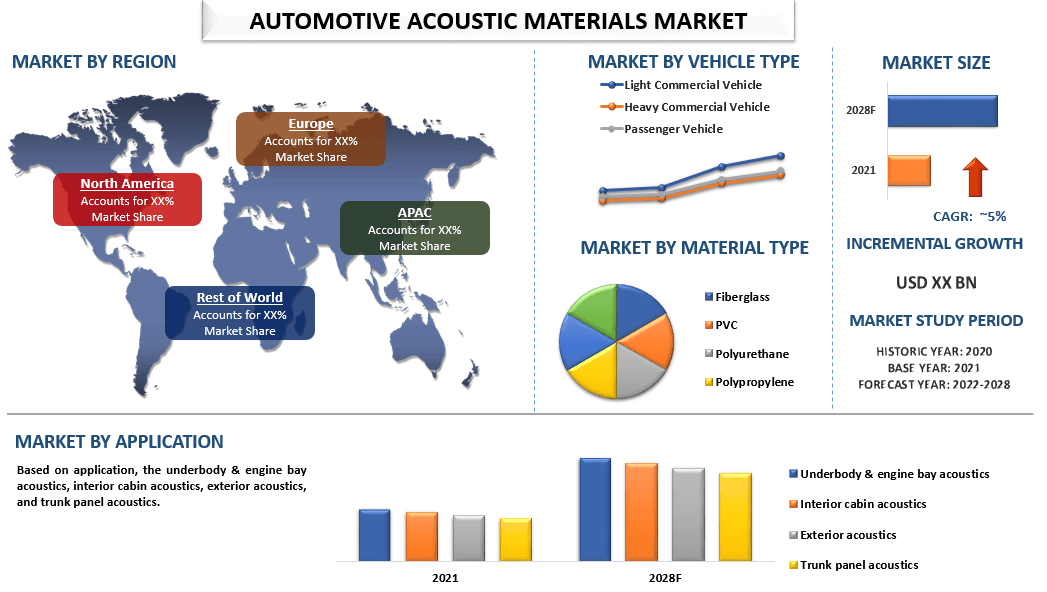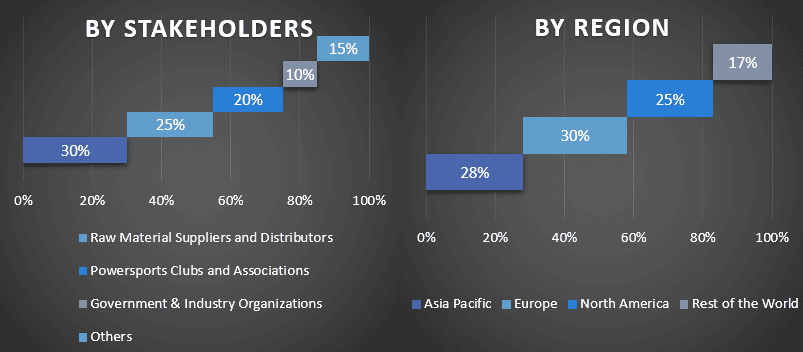- Inicio
- Acerca de nosotros
- Industria
- Servicios
- Leyendo
- Contáctenos
Mercado de materiales acústicos para automoción: Análisis actual y pronóstico (2022-2028)
Énfasis en el tipo de material (fibra de vidrio, PVC, poliuretano, polipropileno, ABS (acrilonitrilo butadieno estireno) y otros); Tipo de vehículo (vehículo comercial ligero, vehículo comercial pesado y vehículo de pasajeros); Aplicación (acústica de bajos y compartimento del motor, acústica interior de cabina, acústica exterior y acústica de panel de maletero); y Región/País

SOLICITAR PDF DE MUESTRA GRATUITA
Se espera que el mercado mundial de materiales acústicos para automoción crezca a un ritmo significativo de alrededor del 5% durante el período de pronóstico.El mercado de materiales acústicos para automoción se refiere a los materiales utilizados en el diseño y la producción de vehículos para reducir el ruido y la vibración. Estos materiales se utilizan en varias partes del vehículo, como el compartimento del motor, los paneles de las puertas y los bajos. Se espera que el mercado mundial de materiales acústicos para automoción crezca a un ritmo constante en los próximos años debido a la creciente demanda de viajes más silenciosos y cómodos. Uno de los factores clave que impulsan el crecimiento del mercado de materiales acústicos para automoción es que los vehículos premium y de lujo suelen estar equipados con materiales acústicos de alta calidad para proporcionar una conducción cómoda y silenciosa. A medida que aumenta la demanda de este tipo de vehículos, también lo hace la demanda de materiales acústicos. Además, varios gobiernos y organismos reguladores han impuesto regulaciones sobre los niveles de ruido emitidos por los vehículos. Esto ha llevado a una mayor demanda de materiales acústicos que puedan reducir los niveles de ruido dentro del vehículo. Además, el desarrollo de materiales nuevos y avanzados que ofrecen un mejor rendimiento acústico está impulsando el crecimiento del mercado. Estos materiales son ligeros, duraderos y rentables, lo que los convierte en una opción atractiva para los fabricantes. En resumen, la demanda de materiales acústicos en la industria automotriz está impulsada por la creciente demanda de vehículos premium y de lujo, regulaciones estrictas, avances tecnológicos, la creciente conciencia sobre la contaminación acústica y la creciente demanda de vehículos eléctricos e híbridos.
BASF SE, DOW, 3M, Covestro AG, HUNTSMAN, Henkel Adhesives Technologies India Private Limited, DuPont., TORAY INDUSTRIES, INC., LyondellBasell Industries Holdings B.V. y Sika son algunos de los actores clave en el mercado. Varias fusiones y adquisiciones, junto con asociaciones, han sido emprendidas por estos actores para facilitar a los clientes productos/tecnologías innovadoras y de alta tecnología.
Información presentada en el informe
“Entre el tipo de material, la categoría abs (acrilonitrilo butadieno estireno) será testigo de un CAGR más alto durante el período de pronóstico”
Según el tipo, el mercado se segmenta en fibra de vidrio, PVC, poliuretano, polipropileno, abs (acrilonitrilo butadieno estireno) y otros. La categoría abs (acrilonitrilo butadieno estireno) será testigo de un CAGR más alto durante el período de pronóstico, ya que el ABS es un material fuerte y duradero que puede resistir impactos y desgaste. Esto lo convierte en una opción popular para aplicaciones automotrices que requieren alto rendimiento y durabilidad. Además, el ABS es un material relativamente de bajo costo en comparación con otras opciones, como la fibra de carbono o el aluminio. Esto lo convierte en una opción atractiva para los fabricantes de automóviles que buscan reducir los costos sin dejar de mantener altos estándares de calidad.
“Entre el tipo de vehículo, el vehículo comercial mantiene un crecimiento significativo en el mercado’’
Sobre la base del tipo de tracción, el mercado se clasifica en vehículo comercial ligero, vehículo comercial pesado y vehículo de pasajeros. Entre estos, los vehículos comerciales mantienen un crecimiento significativo en el mercado. La demanda de vehículos comerciales como camiones, autobuses y furgonetas está creciendo debido a la expansión del comercio electrónico, la logística y los sectores de transporte. Además, los gobiernos y los organismos reguladores han establecido regulaciones de ruido y emisiones para los vehículos comerciales. Estas regulaciones exigen el uso de componentes de reducción de ruido en los vehículos para reducir los niveles de ruido y cumplir con los estándares requeridos.
“Norteamérica mantendrá una cuota significativa en el mercado.”
Norteamérica tiene una cuota significativa en el mercado de materiales acústicos para automoción debido a varios factores, como una industria automotriz fuerte y madura, que es un consumidor importante de materiales acústicos para automoción. Estados Unidos, en particular, alberga a muchos fabricantes de automóviles líderes, incluidos General Motors, Ford y Fiat Chrysler, entre otros. Estos fabricantes de automóviles exigen materiales acústicos de alta calidad para mejorar la comodidad y el aislamiento acústico de sus vehículos. Además, la industria automotriz de América del Norte está sujeta a regulaciones estrictas, incluidas las regulaciones de ruido y emisiones. Las regulaciones exigen el uso de materiales acústicos para reducir el ruido emitido por los vehículos, lo que ha llevado a una mayor demanda de materiales acústicos en la región. Además, los consumidores de América del Norte dan gran importancia a la comodidad y las características de lujo en sus vehículos. Los materiales acústicos son un componente esencial para proporcionar una conducción silenciosa y cómoda, lo que ha llevado a una mayor demanda de estos materiales en la región.
Razones para comprar este informe:
- El estudio incluye el dimensionamiento del mercado y el análisis de pronóstico validado por expertos clave de la industria autenticados.
- El informe presenta una revisión rápida del desempeño general de la industria de un vistazo.
- El informe cubre un análisis en profundidad de los pares prominentes de la industria con un enfoque principal en las finanzas comerciales clave, la cartera de productos, las estrategias de expansión y los desarrollos recientes.
- Examen detallado de los impulsores, restricciones, tendencias clave y oportunidades que prevalecen en la industria.
- El estudio cubre ampliamente el mercado en diferentes segmentos.
- Análisis en profundidad a nivel regional de la industria.
Opciones de personalización:
El mercado mundial de materiales acústicos para automoción se puede personalizar aún más según los requisitos o cualquier otro segmento del mercado. Además de esto, UMI entiende que puede tener sus propias necesidades comerciales, por lo tanto, no dude en contactarnos para obtener un informe que se adapte completamente a sus requerimientos.
Tabla de contenido
Metodología de investigación para el análisis de materiales acústicos para automoción (2022-2028)
El análisis del mercado histórico, la estimación del mercado actual y el pronóstico del mercado futuro del mercado mundial de materiales acústicos para automoción fueron los tres pasos principales realizados para crear y analizar la adopción de materiales acústicos para automoción en las principales regiones del mundo. Se realizó una exhaustiva investigación secundaria para recopilar los números históricos del mercado y estimar el tamaño actual del mercado. En segundo lugar, para validar estos conocimientos, se tomaron en consideración numerosos hallazgos y suposiciones. Además, también se realizaron exhaustivas entrevistas primarias, con expertos de la industria en toda la cadena de valor del mercado mundial de materiales acústicos para automoción. Después de la suposición y validación de los números del mercado a través de entrevistas primarias, empleamos un enfoque de arriba hacia abajo/abajo hacia arriba para pronosticar el tamaño completo del mercado. Posteriormente, se adoptaron métodos de desglose del mercado y triangulación de datos para estimar y analizar el tamaño del mercado de los segmentos y subsegmentos de la industria a la que pertenece. La metodología detallada se explica a continuación:
SOLICITAR PDF DE MUESTRA GRATUITA
Análisis del tamaño histórico del mercado
Paso 1: Estudio en profundidad de fuentes secundarias:
Se realizó un estudio secundario detallado para obtener el tamaño histórico del mercado de materiales acústicos para automoción a través de fuentes internas de la empresa, comoinformes anuales y estados financieros, presentaciones de rendimiento, comunicados de prensa, etc.y fuentes externas, incluyendorevistas, noticias y artículos, publicaciones gubernamentales, publicaciones de la competencia, informes del sector, bases de datos de terceros y otras publicaciones creíbles.
Paso 2: Segmentación del mercado:
Después de obtener el tamaño histórico del mercado de materiales acústicos para automoción, realizamos un análisis secundario detallado para recopilar información histórica del mercado y cuotas para diferentes segmentos y subsegmentos para las principales regiones. Los principales segmentos se incluyen en el informe como tipo de material, tipo de material y aplicación. Además, se realizaron análisis a nivel de país para evaluar la adopción general de modelos de prueba en esa región.
Paso 3: Análisis de factores:
Después de adquirir el tamaño histórico del mercado de diferentes segmentos y subsegmentos, realizamos un detalladoanálisis de factorespara estimar el tamaño actual del mercado de materiales acústicos para automoción. Además, realizamos un análisis de factores utilizando variables dependientes e independientes, como varios tipos de materiales, tipos de vehículos y aplicaciones de materiales acústicos para automoción. Se realizó un análisis exhaustivo de los escenarios de la oferta y la demanda, considerando las principales asociaciones, fusiones y adquisiciones, la expansión comercial y los lanzamientos de productos en el sector del mercado de materiales acústicos para automoción en todo el mundo.
Estimación y previsión del tamaño actual del mercado
Dimensionamiento actual del mercado:Basándonos en la información procesable de los 3 pasos anteriores, llegamos al tamaño actual del mercado, los actores clave en el mercado mundial de materiales acústicos para automoción y las cuotas de mercado de los segmentos. Todas las divisiones de cuotas porcentuales requeridas y los desglose del mercado se determinaron utilizando el enfoque secundario antes mencionado y se verificaron a través de entrevistas primarias.
Estimación y previsión:Para la estimación y previsión del mercado, se asignaron ponderaciones a diferentes factores, incluidos los impulsores y tendencias, las restricciones y las oportunidades disponibles para las partes interesadas. Después de analizar estos factores, se aplicaron técnicas de previsión relevantes, es decir, el enfoque de arriba hacia abajo/abajo hacia arriba, para llegar al pronóstico del mercado para 2028 para diferentes segmentos y subsegmentos en los principales mercados a nivel mundial. La metodología de investigación adoptada para estimar el tamaño del mercado abarca:
- El tamaño del mercado de la industria, en términos de ingresos (USD) y la tasa de adopción del mercado de materiales acústicos para automoción en los principales mercados a nivel nacional
- Todas las cuotas porcentuales, divisiones y desgloses de los segmentos y subsegmentos del mercado
- Actores clave en el mercado mundial de materiales acústicos para automoción en términos de productos ofrecidos. Además, las estrategias de crecimiento adoptadas por estos actores para competir en el mercado de rápido crecimiento
Validación del Tamaño y la Cuota de Mercado
Investigación Primaria:Se realizaron entrevistas en profundidad con los Líderes de Opinión Clave (KOL) incluyendo Ejecutivos de Alto Nivel (CXO/VP, Jefes de Ventas, Jefes de Marketing, Jefes de Operaciones, Jefes Regionales, Jefes de País, etc.) en las principales regiones. Los hallazgos de la investigación primaria se resumieron y se realizó un análisis estadístico para probar la hipótesis establecida. Las entradas de la investigación primaria se consolidaron con los hallazgos secundarios, convirtiendo así la información en conocimientos accionables.
División de los Participantes Primarios en Diferentes Regiones

Ingeniería de Mercado
Se empleó la técnica de triangulación de datos para completar la estimación general del mercado y para llegar a números estadísticos precisos para cada segmento y subsegmento del mercado global de materiales acústicos automotrices. Los datos se dividieron en varios segmentos y subsegmentos después de estudiar varios parámetros y tendencias en las áreas de tipo de material, tipo de vehículo y aplicación en el mercado global de materiales acústicos automotrices.
El objetivo principal del Estudio Global de Materiales Acústicos Automotrices
Las tendencias actuales y futuras del mercado global de materiales acústicos automotrices se identificaron en el estudio. Los inversores pueden obtener información estratégica para basar su discreción para inversiones en el análisis cualitativo y cuantitativo realizado en el estudio. Las tendencias actuales y futuras del mercado determinaron el atractivo general del mercado a nivel regional, proporcionando una plataforma para que el participante industrial explote el mercado sin explotar para beneficiarse de una ventaja de primer movimiento. Otros objetivos cuantitativos de los estudios incluyen:
- Analizar el tamaño actual y previsto del mercado de materiales acústicos automotrices en términos de valor (USD). Además, analizar el tamaño actual y previsto del mercado de diferentes segmentos y subsegmentos
- Los segmentos en el estudio incluyen áreas de tipo de material, tipo de vehículo y aplicación.
- Definición y análisis del marco regulatorio para los materiales acústicos automotrices
- Analizar la cadena de valor involucrada con la presencia de varios intermediarios, junto con el análisis de los comportamientos de los clientes y competidores de la industria.
- Analizar el tamaño actual y previsto del mercado de materiales acústicos automotrices para la región principal.
- Los principales países de las regiones estudiadas en el informe incluyen Asia Pacífico, Europa, América del Norte y el Resto del Mundo.
- Perfiles de empresas del mercado de materiales acústicos automotrices y las estrategias de crecimiento adoptadas por los actores del mercado para mantenerse en el mercado de rápido crecimiento
- Análisis en profundidad a nivel regional de la industria
Relacionados Informes
Los clientes que compraron este artículo también compraron










